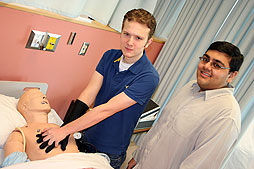From the
Sun Sentinel:
The Coral Springs mother went to the emergency room feeling sick after running out of medicine. But instead of just getting a refill, she died when a nurse gave her a massive overdose of a seizure drug, according to hospital officials and state records.The nurse at Broward General Medical Center injected Michelene Plass, 44, with 10 times the dose the doctor ordered, officials said. To get that much, nurse Dionne Cooper had to round up 32 vials of the drug. Plass died in minutes.
Plass' death in April is getting fresh scrutiny, as an outgrowth of a lawsuit filed by her ER doctor, Paul Rohart, who contends he was unfairly dismissed. The nurse also was fired. After Rohart contacted them last week, Broward County prosecutors asked Fort Lauderdale police to begin a criminal review of the case and the nation's hospital accrediting group agreed to examine Broward General's response to the death.Rohart and Plass' mother said that they were stunned that Cooper would give such a high dosage without double-checking the script and that the hospital's safety system did not catch the error.
On April 23, Plass had a seizure and was rushed to the hospital, her mother said. She was discharged with a refill of her medicine, but before she could leave, she had another seizure in a bathroom, records show.
Rohart, an ER specialist for eight years and a doctor since 1989, said he ran tests and prescribed 800 milligrams of the anti-seizure drug Dilantin. "She and I were laughing when I left for the day," Rohart said.But Cooper instead administered 8000 mg (eight grams), quickly stopping Plass' heart, hospital officials said. T
he fatal dosage is two to five grams."Her husband called me to say they were releasing her from the hospital," Peggy Plass said. "Then 10 minutes later he called to say she was dead."The correct dose required 3.2 vials of the drug. Cooper gave Plass 32 vials, hospital administrator Joe Scott said. To get that many, she had to search the halls and take every vial from three computerized drug-dispensing machines, he said. "That would be a big red flag," Scott said.




